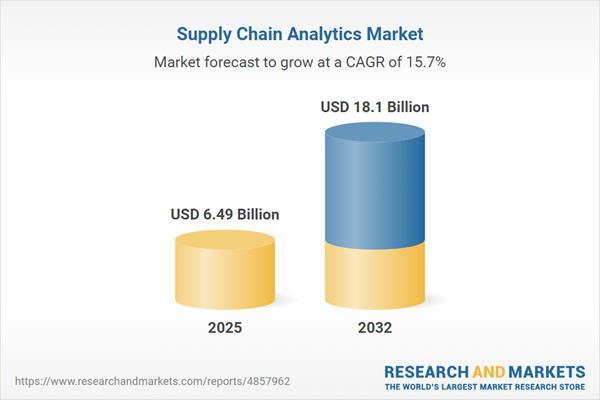Speak directly to the analyst to clarify any post sales queries you may have.
Supply chain analytics is rapidly redefining operational agility and risk management for enterprises worldwide. Senior decision-makers are leveraging advanced analytics platforms to support resilience, efficiency, and competitive positioning across increasingly complex global value chains.
Market Snapshot: Growth and Opportunities in the Supply Chain Analytics Market
The supply chain analytics market grew from USD 5.64 billion in 2024 to USD 6.49 billion in 2025. Sustained expansion continues at a CAGR of 15.66% and is forecast to reach USD 18.10 billion by 2032. This growth is driven by organizations’ ongoing investments in real time analytics, machine learning, and digital transformation initiatives that strengthen supply chain visibility and responsiveness while adapting to shifting regulatory, trade, and technology conditions.
Scope & Segmentation: What This Analysis Covers
- Component Types: Hardware (automation systems, IoT devices, sensors), services (consulting, managed services, support & maintenance), and software (cloud-based platforms, integrated solutions).
- Deployment Models: Cloud-based and on-premise architectures.
- Organization Sizes: Large enterprises; small & medium enterprises.
- Applications: Inventory management (demand forecasting, order management), procurement (contract negotiation, supplier relationship management), transportation management (freight rating, route optimization).
- Industry Verticals: Food & beverage (beverage suppliers, packaged foods), healthcare (medical device distribution, pharmaceutical supply chains), manufacturing (aerospace, automotive), retail & e-commerce (brick-and-mortar, online retail).
- Regions: Americas (United States, Canada, Mexico, Brazil, Argentina, Chile, Colombia, Peru), Europe, Middle East, Africa (United Kingdom, Germany, France, Russia, Italy, Spain, Netherlands, Sweden, Poland, Switzerland, United Arab Emirates, Saudi Arabia, Qatar, Turkey, Israel, South Africa, Nigeria, Egypt, Kenya), and Asia-Pacific (China, India, Japan, Australia, South Korea, Indonesia, Thailand, Malaysia, Singapore, Taiwan).
- Key Technologies: Edge computing, blockchain, digital twins, AI-powered modeling, and IoT sensor networks.
- Leading Companies: Accenture plc, Capgemini SE, Genpact Limited, Google LLC by Alphabet Inc., International Business Machines Corporation, Lockheed Martin Corporation, Oracle Corporation, SAP SE, SAS Institute Inc., Koch, Inc.
Key Takeaways for Senior Decision-Makers
- Real time data integration enhances visibility into global supply chain performance, enabling agile responses to market disruptions and shifting demand patterns.
- Machine learning algorithms and predictive analytics are now essential for proactive risk mitigation, demand shaping, and resource optimization across diverse industries.
- Digital infrastructure advancements, such as edge computing and IoT, support lower latency decision-making at distribution centers and transportation hubs, improving overall supply chain responsiveness.
- Collaborative data ecosystems and strategic partnerships between analytics providers and logistics firms are amplifying ecosystem-wide resilience and sharing actionable insights across enterprise boundaries.
- Segmentation by industry vertical and organization size allows for tailored analytics strategies, supporting specialized supply chain use cases in sectors such as healthcare, food & beverage, and retail.
Tariff Impact: Navigating Regulation and Cross-Border Complexity
The imposition of new US tariffs in 2025 introduces fresh challenges for supply chain analytics strategies. Organizations are refining their sourcing playbooks and recalibrating cost models to account for evolving tariff structures and increased trade compliance requirements. Analytics teams are now expected to integrate tariff rate tracking, scenario-based modeling, and real time compliance monitoring to safeguard service levels and profitability while reducing the risk of customs-related delays.
Methodology & Data Sources
This research applies primary interviews with senior executives, in-depth review of published industry documentation, statistical analyses, and expert validation workshops. Multiple data sources and perspectives are triangulated to ensure robust, actionable, and accurate insights for decision-making confidence.
The Role of Supply Chain Analytics: Why This Report Matters
- Unlock comprehensive, actionable intelligence to guide investment in analytics technologies, bolster resilience, and accelerate transformation agendas.
- Benchmark vendors, deployment models, and segmentation trends to inform technology selection and market entry strategies in a rapidly evolving landscape.
- Stay ahead of emerging tariff, regulatory, and digital trends impacting global supply chain innovation, efficiency, and compliance.
Conclusion
Supply chain analytics is an essential strategic lever for cost optimization, innovation, and risk mitigation. Organizations that act on these insights lay the groundwork for sustainable growth, operational resilience, and long-term competitiveness.
Additional Product Information:
- Purchase of this report includes 1 year online access with quarterly updates.
- This report can be updated on request. Please contact our Customer Experience team using the Ask a Question widget on our website.
Table of Contents
3. Executive Summary
4. Market Overview
7. Cumulative Impact of Artificial Intelligence 2025
Companies Mentioned
The companies profiled in this Supply Chain Analytics market report include:- Accenture plc
- Capgemini SE
- Genpact Limited
- Google LLC by Alphabet Inc.
- International Business Machines Corporation
- Lockheed Martin Corporation
- Oracle Corporation
- SAP SE
- SAS Institute Inc.
- Koch, Inc.
Table Information
| Report Attribute | Details |
|---|---|
| No. of Pages | 198 |
| Published | November 2025 |
| Forecast Period | 2025 - 2032 |
| Estimated Market Value ( USD | $ 6.49 Billion |
| Forecasted Market Value ( USD | $ 18.1 Billion |
| Compound Annual Growth Rate | 15.6% |
| Regions Covered | Global |
| No. of Companies Mentioned | 11 |









